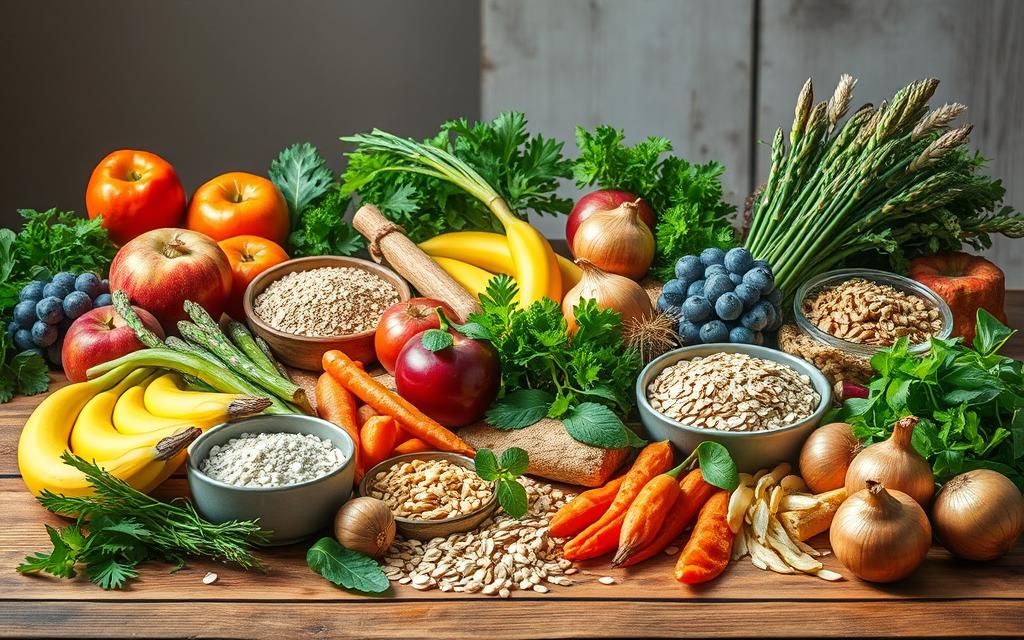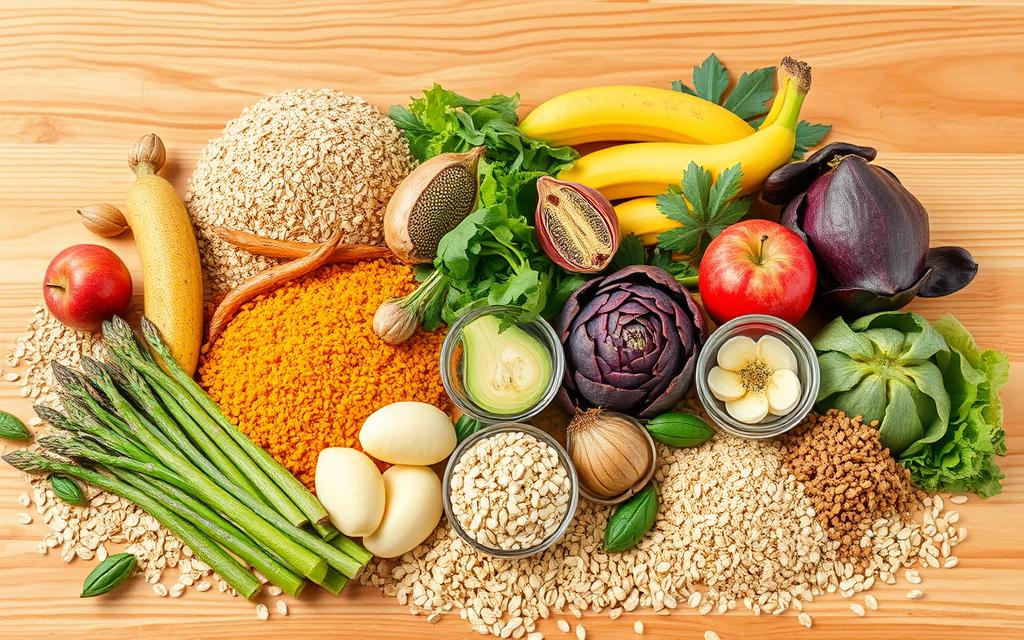Prebiotic Foods: Boost Your Gut Health Naturally
Discover the power of prebiotic foods to enhance your gut health. These fiber-rich foods feed the friendly bacteria in your digestive system, promoting a healthier you. Unlike probiotics, which are live bacteria, prebiotics act as fuel for your gut’s beneficial microbes.
Chicory root is a top prebiotic food, packed with about 68% inulin fiber. This fiber boosts friendly bacteria in your colon and supports digestive health1. Jerusalem artichokes and garlic are also great sources, full of fructans that help beneficial gut bacteria grow2.
Bananas, especially the unripe ones, have inulin and resistant starch that help with prebiotics1. Whole grains like barley and oats are full of beta-glucan, a prebiotic fiber. This fiber can lower cholesterol and reduce heart disease risk12.
By adding these prebiotic foods to your diet, you’re taking a big step towards better gut health and overall well-being. Let’s dive deeper into these digestive system superheroes and how they can change your health for the better.
Key Takeaways
- Prebiotic foods feed beneficial gut bacteria
- Chicory root and Jerusalem artichokes are top prebiotic sources
- Unripe bananas offer resistant starch with prebiotic effects
- Whole grains contain beta-glucan, a powerful prebiotic fiber
- Diverse plant-based foods ensure a well-rounded prebiotic intake
- Prebiotics support digestive health and overall well-being
Understanding Prebiotics and Gut Health
Prebiotics are key for your digestive health. They are plant fibers that feed good gut bacteria. This helps them grow and work better in your system3.
What are prebiotics?
Prebiotics are special carbs in plants. They include inulin, fructooligosaccharides (FOS), and galactooligosaccharides (GOS)4. You can find them in foods like garlic, onions, bananas, and whole grains3.

The role of prebiotics in digestive health
Eating prebiotic foods helps good bacteria in your gut grow. This leads to better digestion, better nutrient use, and helps control blood sugar3. Prebiotics also lower inflammation and may reduce the risk of some diseases54.
Differences between prebiotics and probiotics
Prebiotics feed gut bacteria, while probiotics are live organisms that balance your gut flora. Probiotics are in foods like yogurt and kefir3. Eating both prebiotics and probiotics boosts your gut health even more4.
Adding prebiotic foods to your diet helps your gut microbiome. But, eating too much fiber at once might cause gas and bloating. So, start slowly3.
The Science Behind Prebiotic Foods
Prebiotic foods are key to a healthy gut microbiome. They feed the good bacteria in your gut, keeping things balanced. Americans eat inulin and oligofructose, which are important prebiotics6.
When you eat prebiotics, your gut bacteria turn them into short-chain fatty acids. These acids can go into your bloodstream and boost your health7. Eating more prebiotics can change your gut bacteria for the better7.
Prebiotics and gut health are closely linked. Studies show that gut bacteria differ in heavy and light people6. This means prebiotics could help with weight and metabolic health.
Oligosaccharides, a type of prebiotic fiber, help good bacteria grow in your colon7. This can make digestion better, boost your immune system, and even change your mood.
Scientists are still learning about prebiotic foods. They’ve found new sources like cocoa flavanols and plant cell wall polysaccharides7. These could be new ways to improve gut health through diet.
Top Prebiotic Foods to Include in Your Diet
Eating prebiotic foods is a great way to boost your gut health. These foods have special fibers that feed the good bacteria in your gut. Let’s explore some top prebiotic foods you can add to your meals.
Chicory Root and Dandelion Greens
Chicory root is a powerhouse of inulin, a type of prebiotic fiber. It’s one of the most studied prebiotic sources and can greatly improve your gut health8. Dandelion greens are also rich in inulin, making them a great addition to salads or smoothies.
Jerusalem Artichoke and Garlic
Jerusalem artichokes, also known as sunchokes, are packed with inulin. They’re best eaten raw to get the most prebiotic benefits8. Garlic is another prebiotic superstar. It’s high in inulin-type fructans and can help improve digestion, especially for people with certain health conditions8.
Onions and Leeks
Onions and leeks are excellent sources of prebiotic fiber. They contain inulin and fructooligosaccharides (FOS), which are great for feeding your gut bacteria. Try adding raw onions to salads or cooking leeks in soups for a prebiotic boost.
Asparagus and Bananas
Asparagus is rich in fructans like inulin. Eating asparagus regularly may help reduce the risk of chronic health issues8. Green bananas are another great choice. They contain resistant starch, a type of prebiotic that can help manage blood sugar levels8.
| Food | Prebiotic Type | Benefits |
|---|---|---|
| Chicory Root | Inulin | Improves gut health |
| Garlic | Inulin-type fructans | Aids digestion |
| Asparagus | Fructans | Reduces chronic disease risk |
| Green Bananas | Resistant starch | Helps manage blood sugar |
Remember, when adding prebiotic foods to your diet, start with small amounts and slowly increase to avoid digestive discomfort9. By including these prebiotic-rich foods in your meals, you’re taking a big step towards better gut health.
Whole Grains as Prebiotic Powerhouses
Whole grains are not just nutritious; they’re also excellent sources of prebiotic foods. These grains contain various types of fiber that nourish beneficial gut bacteria. This helps with digestive health and overall well-being.
Barley: A Beta-Glucan Boost
Raw barley is a fiber-rich powerhouse, containing an impressive 15.6 g of fiber per 100 g10. It’s known for its high beta-glucan content. Beta-glucan is a type of prebiotic fiber that offers many health benefits.
It helps lower cholesterol levels and improve blood sugar control. So, barley is a smart choice for heart and digestive health.
Oats: Prebiotic Potential Unleashed
Oats are another excellent source of prebiotic fiber, boasting 15.4 g of fiber per 100 g10. Like barley, oats are rich in beta-glucan and resistant starch. These prebiotics support gut health and help lower cholesterol.
Adding oats to your diet is easy. Enjoy a warm bowl of oatmeal or use them in baked goods.
Whole Wheat: A Prebiotic Staple
Whole wheat rounds out the trio of prebiotic-rich grains. It’s an excellent source of arabinoxylan oligosaccharides (AXOS). AXOS is a type of prebiotic fiber that increases beneficial Bifidobacteria in the gut.
Incorporating whole wheat into your diet through bread, pasta, or cereals can significantly boost your prebiotic intake.
| Whole Grain | Fiber Content (per 100g) | Key Prebiotic Component |
|---|---|---|
| Barley | 15.6 g | Beta-glucan |
| Oats | 15.4 g | Beta-glucan, Resistant starch |
| Whole Wheat | 12.2 g | AXOS |
By incorporating these whole grains into your diet, you can significantly increase your intake of prebiotic foods. This supports your gut health and overall well-being. A diverse diet rich in whole grains and other prebiotic foods is key to maintaining a healthy gut microbiome.
Fruits Rich in Prebiotic Fiber
Fruits are a tasty way to get more prebiotic foods. Many fruits have natural stuff that helps good gut bacteria grow. This supports your digestive health and overall well-being.
Apples are a top choice for prebiotics. Their skin has pectin, a fiber that helps good gut bacteria grow. Eating an apple feeds your gut microbes and boosts short-chain fatty acid production11.
Bananas, especially when green, are full of prebiotics. They have a lot of resistant starch, which is a prebiotic in your gut. As bananas ripen, their prebiotic levels change, but they’re still good for your gut11.
Kiwifruit is great for your gut too. It has soluble fiber and polyphenols that help good bacteria grow. Eating kiwis often can increase short-chain fatty acid production in your gut11.
Other fruits that are good for your gut include:
- Blueberries: Rich in polyphenols and dietary fiber11
- Grapefruits: High in fiber and antioxidant vitamins11
- Berries: Contain various prebiotic compounds12
Don’t just look at fresh fruits for prebiotics. Some packaged foods now have added prebiotics. Look for ingredients like inulin, chicory fiber, or fructooligosaccharides to find these foods12.
| Fruit | Prebiotic Compounds | Benefits |
|---|---|---|
| Apples | Pectin | Stimulates probiotic growth |
| Bananas | Resistant starch, Inulin | Feeds beneficial bacteria |
| Kiwifruit | Soluble fiber, Polyphenols | Supports short-chain fatty acid production |
Adding these fruits to your diet can really help your gut health. Remember, eating a variety of fruits is best for your gut microbiome. Try to include different fruits in your meals and snacks.
Vegetables That Pack a Prebiotic Punch
Discover the power of plant-based prebiotics in your favorite veggies. These natural wonders support your gut health and overall well-being. Let’s explore some standout vegetables that are rich in prebiotic foods.
Artichokes: Inulin Powerhouses
Artichokes are stars in the world of prebiotic foods. They’re packed with inulin, a type of fiber that feeds your gut’s good bacteria. Chicory root, another inulin-rich food, contains up to 68% of this prebiotic fiber in its dry weight13. Add artichokes to your salads or enjoy them grilled for a tasty prebiotic boost.
Jicama Root: A Crunchy Prebiotic Treat
Jicama root is a lesser-known prebiotic powerhouse. This crunchy vegetable is low in calories but high in inulin fiber. It may help improve your digestive health and even lower blood sugar levels. Enjoy jicama raw in salads or as a refreshing snack.
Konjac Root: Glucomannan Goodness
Konjac root is a unique vegetable that contains glucomannan fiber. This plant-based prebiotic promotes the growth of beneficial gut bacteria. You can find konjac in various forms, including noodles and flour, making it easy to incorporate into your meals.
Other vegetables rich in prebiotics include garlic, leeks, and onions. These foods contain between 100 to 240 milligrams of prebiotics per gram, making them excellent choices for gut health14. Asparagus is another great option, providing both inulin and folate13.
By including these prebiotic-rich vegetables in your diet, you’re taking a significant step towards better digestive health. Remember, variety is key when it comes to nurturing your gut microbiome with plant-based prebiotics.
Legumes: A Prebiotic Goldmine
Legumes are true champions of plant-based prebiotics. They are full of fiber and protein, making them key for a healthy diet. Black beans, chickpeas, lentils, and peas are great examples of these prebiotic foods15.
These foods are loaded with galacto-oligosaccharides, a prebiotic that feeds your gut bacteria. Eating legumes helps you and your gut bacteria. This supports gut health and may lower inflammation.
Legumes are also very versatile. You can put them in soups, salads, or make them the main dish. A half-cup of cooked lentils gives you about 8 grams of fiber, boosting your daily intake.
- Black beans
- Chickpeas
- Lentils
- Edamame
Some people might feel gassy after eating legumes. But don’t worry, it means your gut bacteria are working hard. They are fermenting the prebiotic fiber, which is important for health.
Adding legumes to your meals is a big step towards better gut health. They are easy and tasty ways to increase your prebiotic food intake and support your digestive system naturally16.
Nuts and Seeds with Prebiotic Properties
Nuts and seeds are great for your gut health. They are full of prebiotics, which help your digestive system. These foods are tiny but powerful.
Almonds and their prebiotic benefits
Almonds are packed with prebiotic fiber. Eating almonds often can make your body healthier. Studies show they can help with weight loss and lower blood pressure17.
Almonds are better for you than refined snacks when you’re watching calories17.
Flaxseeds and their gut-friendly qualities
Flaxseeds are also great for your gut. They are full of fiber, which helps good bacteria grow and keeps your bowels regular. Adding flaxseeds to your meals can help with metabolic syndrome17.
These small seeds are easy to add to many foods, like smoothies or baked goods.
Other nuts and seeds have benefits too. Pistachios help with weight and metabolism in people with metabolic syndrome17. Walnuts can also help with weight in older people17.
Adding different nuts and seeds to your meals can boost your health. Studies show they can change your gut bacteria for the better, improving how well you use nutrients and your overall health18. Choosing these foods is a smart way to care for your gut and overall health.
Prebiotic Foods in Different Cuisines
Prebiotic foods are key in many global cuisines, adding flavor and health benefits. They are often found in traditional diets, showing the value of ancient eating habits.
In the Mediterranean and Asia, garlic and onions are common. They are full of prebiotics. The Middle East and India love legumes for their prebiotic goodness. Northern Europe focuses on whole grains like barley and oats, which are rich in prebiotic fiber.
Fermented foods are big in many cultures, packed with probiotics and prebiotics. Korean kimchi and German sauerkraut are great examples. These foods not only taste great but also help with digestion.
| Cuisine | Common Prebiotic Foods | Traditional Dishes |
|---|---|---|
| Mediterranean | Garlic, Onions, Legumes | Hummus, Greek Salad |
| Asian | Garlic, Soybeans, Bananas | Miso Soup, Stir-fries |
| Middle Eastern | Chickpeas, Wheat, Dates | Falafel, Tabbouleh |
| Northern European | Barley, Oats, Apples | Barley Soup, Muesli |
Studies found that 37% of foods tested had prebiotics19. The top five foods had 79-243 milligrams of prebiotics per gram. This shows how important it is to eat a variety of prebiotic foods.
Exploring global cuisines makes it easy to add prebiotic foods to your meals. This not only makes cooking more fun but also boosts your gut health. It can even improve your overall health and well-being.
Incorporating Prebiotic Foods into Your Daily Meals
Adding prebiotic foods to your meals can make a big difference in your gut health and overall health. Let’s look at tasty ways to include these important ingredients in your daily meals.
Breakfast Ideas with Prebiotic Ingredients
Start your day with a prebiotic-rich breakfast. Try oatmeal with underripe bananas for extra prebiotic fiber20. Add chia seeds or ground flaxseeds for more gut-friendly bacteria and less inflammation20.
Lunch and Dinner Recipes Rich in Prebiotics
For lunch and dinner, use a mix of prebiotic foods. Beans and legumes are great, full of galactooligosaccharides that help beneficial gut bacteria20. Try a bean soup or a salad with asparagus and Jerusalem artichokes for inulin, a prebiotic that helps with fullness and blood sugar control21.
Prebiotic-Packed Snacks and Desserts
Snack on apple slices with almond butter or jicama sticks for a tasty prebiotic boost. For dessert, enjoy dark chocolate for its gut-friendly cocoa polyphenols20. Or, try a chia seed pudding with berries for the prebiotic benefits of chia seeds and the fiber-rich fruits21.
| Meal | Prebiotic Foods | Benefits |
|---|---|---|
| Breakfast | Oatmeal, bananas, chia seeds | High in fiber, promotes gut health |
| Lunch | Bean soup, asparagus salad | Boosts beneficial bacteria, aids digestion |
| Dinner | Stir-fry with garlic and leeks | Supports immune function, reduces inflammation |
| Snacks | Apple slices, dark chocolate | Increases good bacteria, provides antioxidants |
Start adding prebiotic foods slowly to your diet to avoid discomfort. It’s best to eat them during the day when your gut is most active21. By using these healthy recipes in your meal planning, you’ll improve your gut health and overall wellness.
The Impact of Cooking on Prebiotic Content
Cooking methods are key to the prebiotic content in foods. Raw foods keep their full prebiotic power. But, some cooking methods can boost these benefits. Knowing how heat changes fiber content helps you get the most health benefits from prebiotic foods.
Studies show that different cooking ways change the gut microbiome-influencing compounds in food. Frying and boiling affect the microbiota in unique ways. The Lachnospiraceae and Ruminococcaceae families are most affected22.
Some cooking methods increase the prebiotic content in foods. For example, cooking and cooling potatoes boosts their resistant starch. This is a type of prebiotic fiber. Lightly steaming vegetables like asparagus makes them easier to digest and keeps their prebiotic benefits.
A study looked at over 8,600 foods and found 37% had prebiotics. Foods like dandelion greens, Jerusalem artichokes, garlic, leeks, and onions were top in prebiotic content. They had 100-240 milligrams of prebiotics per gram23. This shows the value of eating both raw and cooked prebiotic foods.
To get enough prebiotics, mix raw and cooked foods in your diet. Enjoy raw garlic in dressings, steam asparagus lightly, or roast Jerusalem artichokes. Aim for 5 grams of prebiotics a day, which is about half a small onion23. By balancing your cooking, you can get a diverse and helpful prebiotic profile in your meals.
Potential Side Effects and Considerations
Prebiotic foods are great for your health, but it’s important to know about possible side effects. They can help your digestive health, but some people might feel a bit uncomfortable at first24.
Digestive Discomfort and Adjustment Period
Adding more prebiotic foods to your diet might make you feel gassy, bloated, or a bit uncomfortable in your stomach. This is because your gut is getting used to more fiber. These feelings should get better as your body adjusts2425. To feel better, start with a little bit of prebiotic foods and slowly add more.
Who Should Be Cautious with Prebiotic Intake
If you have irritable bowel syndrome (IBS), be careful with prebiotics. A study in 2013 found that too much prebiotic could make IBS worse because of the high FODMAP content24. People with acid reflux might also see more symptoms with a lot of prebiotics25. If you have digestive issues or gut sensitivity, talk to your doctor before eating more prebiotics.
The daily fiber you need is between 25 and 38 grams for good prebiotic effects24. By adding prebiotic foods slowly and listening to how you feel, you can enjoy their benefits without the discomfort.
FAQ
What are prebiotics?
Prebiotics are dietary fibers that feed the good bacteria in your gut. They help keep your digestive system healthy. Unlike probiotics, they aren’t live bacteria but help the good gut microbes grow.
How do prebiotics differ from probiotics?
Unlike probiotics, which are live microorganisms, prebiotics are fibers that feed the good bacteria in your gut. Probiotics add new bacteria, while prebiotics help the good ones grow.
What are the benefits of consuming prebiotic foods?
Eating prebiotic foods supports your digestive health by helping good gut bacteria grow. They can ease digestive problems, boost your immune system, and might improve metabolic health by making short-chain fatty acids that your body can use.
Which foods are rich in prebiotics?
Top prebiotic foods include chicory root, dandelion greens, Jerusalem artichoke, garlic, onions, leeks, asparagus, bananas, barley, oats, whole wheat, apples, kiwifruit, artichokes, jicama, konjac root, legumes, almonds, and flaxseeds.
How can I incorporate more prebiotic foods into my diet?
Add prebiotic-rich foods to your meals and snacks. Try oatmeal with bananas and almonds for breakfast, salads with Jerusalem artichokes and chicory for lunch, stir-fries with garlic and leeks for dinner, and jicama sticks or apple slices with almond butter as snacks.
Does cooking affect the prebiotic content of foods?
Cooking can change the fiber in prebiotic foods, but some methods like steaming or cooking and cooling potatoes might keep or even boost their prebiotic benefits. Eating these foods raw is best to get the most health benefits.
Are there any potential side effects of consuming prebiotic foods?
Some might feel more gas, bloating, or mild cramps when eating more prebiotics, especially if they already have gut issues. Start with small amounts and slowly increase them. If you’re on a low FODMAP diet, talk to your doctor before adding prebiotics.
Source Links
- London School of Personal Developement
- https://www.healthline.com/nutrition/19-best-prebiotic-foods – 19 Prebiotic Foods You Should Eat
- https://www.eatingwell.com/article/8052689/best-prebiotic-foods-for-better-gut-health/ – The 8 Best Prebiotic Foods for Better Gut Health, According to Dietitians
- https://www.bjc.org/news/probiotics-and-prebiotics-what-you-need-know-balanced-gut – Probiotics and prebiotics: What you need to know for a balanced gut – BJC HealthCare
- https://campuspress.yale.edu/wave/unlocking-the-power-of-prebiotics-for-digestive-health/ – Unlocking the Power of Prebiotics for Digestive Health
- https://www.healthline.com/nutrition/probiotics-and-prebiotics – Probiotics and Prebiotics: What’s the Difference?
- https://www.ncbi.nlm.nih.gov/pmc/articles/PMC6041804/ – Health Effects and Sources of Prebiotic Dietary Fiber
- https://www.ncbi.nlm.nih.gov/pmc/articles/PMC6463098/ – Prebiotics: Definition, Types, Sources, Mechanisms, and Clinical Applications
- https://www.forbes.com/health/nutrition/best-prebiotic-foods/ – Best Prebiotic Foods You Should Eat, According To Experts
- https://www.chop.edu/health-resources/food-medicine-prebiotic-foods – Food as Medicine: Prebiotic Foods
- https://www.medicalnewstoday.com/articles/323214 – The 19 best prebiotic foods suitable for vegans
- https://upliftfood.com/blogs/news/top-5-prebiotic-fiber-rich-fruits?srsltid=AfmBOoptF5__dlZV5ahGO8eXD11TXnG0ywnC3I6CqGZKAqt0fYw8RfSM – Top 5 Prebiotic Fiber-Rich Fruits
- https://news.va.gov/94616/fruits-vegetables-and-prebiotics-a-tasty-way-to-a-healthy-gut/ – Fruits, vegetables and prebiotics: a tasty way to a healthy gut – VA News
- https://zoe.com/learn/prebiotic-foods – 16 Great Foods for Prebiotics
- https://vegnews.com/vegetables-gut-health-prebiotics-study – These 5 Vegetables Are the Best Sources of Prebiotics, Study Finds
- https://thehappypear.ie/articles/boost-your-gut-health-with-fiber-the-plant-based-secret-to-digestive-bliss/ – The Happy Pear – Plant Based Vegan Recipes Lifestyle Courses
- https://www.cspinet.org/article/5-things-know-about-probiotics-hype – 5 things to know about probiotics hype
- https://www.ncbi.nlm.nih.gov/pmc/articles/PMC6266159/ – Potential Prebiotic Properties of Nuts and Edible Seeds and Their Relationship to Obesity
- https://www.ncbi.nlm.nih.gov/pmc/articles/PMC8002343/ – Plant Prebiotics and Their Role in the Amelioration of Diseases
- https://www.medicalnewstoday.com/articles/the-best-food-sources-for-prebiotics – Gut health: Scientists name top 5 prebiotic-rich foods
- https://www.everydayhealth.com/digestive-health/tasty-ways-to-incorporate-more-prebiotics-into-your-diet/ – Tasty Ways to Incorporate More Prebiotics Into Your Diet
- https://health.clevelandclinic.org/what-are-prebiotics – What Are Prebiotics and What Do They Do?
- https://www.ncbi.nlm.nih.gov/pmc/articles/PMC10800916/ – Effects of different foods and cooking methods on the gut microbiota: an in vitro approach
- https://nutrition.org/scientists-name-top-five-foods-rich-in-prebiotics/ – Scientists name top five foods rich in prebiotics – American Society for Nutrition
- https://www.verywellhealth.com/prebiotics-and-ibs-1944748 – The Best Prebiotic Foods for Better Health
- https://pubmed.ncbi.nlm.nih.gov/15220662/ – Tolerance of probiotics and prebiotics – PubMed







